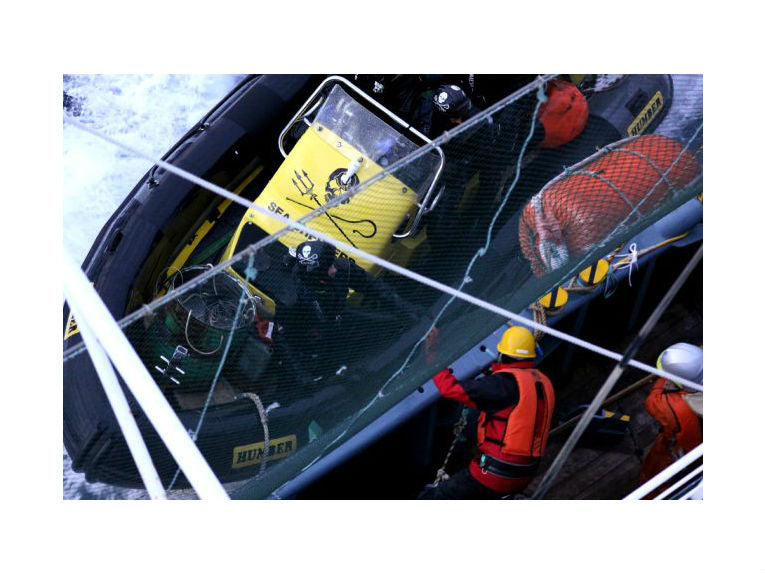Three anti-whaling campaigners were injured earlier today while attempting to disable the Yushin Maru No 2, a Japanese harpoon whaling vessel. Two of the crew on the Sea Shepherd Conservation Society's (SSCS) Steve Irwin protest boat received shoulder and arm bruising from iron grappling hooks and another suffered facial cuts when hit by a bamboo pole, according to SSCS. Two Japanese crewmen were splattered with paint in glass bottles.
This is the second time in a week that the Steve Irwin crew has attacked the Yushin Maru No 2 (YS2) whaling ship. No-one was injured in the previous incident. The Steve Irwin crew say they continue to be tailed by YS2.
The Institute of Cetacean Research (ICR), which specialises in the biological and social sciences related to whales, has condemned the "illegal attack" for putting both crews in danger.
The Steve Irwin's Captain, Paul Watson says, "Our small boats were attempting to slow down the Japanese harpoon vessel Yushin Maru No 2, which is aggressively tailing the Steve Irwin.
"Two of the three harpoon vessels have been assigned to tail Sea Shepherd ships, effectively knocking out two of the three killing boats."
The latest attack happened off the Antarctic coast, around 550km (300 miles) north of Mawson Peninsula.
Steve Irwin crew members Russell Bergh, from South Africa, (35) a cameraman for the Animal Planet TV show, and French photographer, Guillaume Collet, (27) were both hit on their right arms with grappling hooks, it is alleged.
Brian Race, (25) a crewmember from New York, received cuts above his right eye and on his nose from the bamboo pole.
The ICR claims campaigners, armed with a knife and ropes with hooks, tried to disable the research ship's rudder and propeller. They also claim that glass bottles filled with paint were thrown during the incident, which lasted for almost two hours.
The whaling ship used its water pump and the bamboo pole to push back the protesters and tried to stop the ropes getting to the propeller according to the ICR.

Credit: Institute of Cetacean Research
"The activists threw ropes with hooks attached to their ends several times toward the YS2 protective nets. In addition, directly aiming to the YS2 crew, the activists threw at least 30 paint-containing glass bottles.
"In addition to that, coming alongside the YS2 brandishing a knife, the activists cut the fixing rope of one of the intruder-prevention protective float fenders and ripped the protective net set on both sides of the YS2. Their behaviour points to an attempt to illegally board the YS2."
The final damage sustained by the YS2 has not yet been confirmed, although it is known that one of the bow float fenders, aimed at preventing intruders, was taken.
The Institute of Cetacean Research strongly condemns the continuing "dangerous and violent actions" of the Sea Shepherd Conservation Society against the integrity of Japan's whale research vessels and crews.
"Their illegal intrusion attempt and their destruction and stealing of property is tantamount to piracy and should not be condoned," it says.
According to the International Convention for the Regulation of Whaling, Japan's research whaling in the Antarctic is a legal activity but it is one that is frequently and repeatedly condemned across the globe.
"Once again, we call on all related countries including the Netherlands which is the SI flag state and Australia which is the home port of the Sea Shepherd vessels to take every measure available to restrain them and deal with their criminal actions in a strict and objective manner according to their international and domestic obligations."
The Institute of Cetacean Research was founded in October 1987 and is a non-profit research body.
The Sea Shepherd Conservation Society was established in 1977 as an international non-profit, marine wildlife conservation body. It aims to end the slaughter of ocean wildlife and destruction of habitat.
SSCS says it uses innovative direct-action tactics to investigate, document, and take action to expose and confront illegal activities on the high seas.










